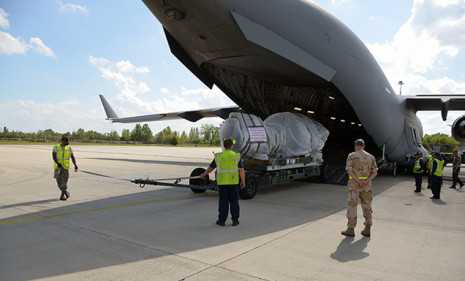SAC Programme Receives First Permanent C-17 Engine
Szöveg: Captain (OF-2) Henrik Gebhardt/Swedish Air Force | 2017. június 22. 21:1419 JUN 2017 – PÁPA – – The SAC Program have received delivery of its first-ever permanently stationed C-17 engine. The 11-million dollar Pratt and Whitney F117 engine, which is the most expensive single piece of a C-17, gives the SAC the capability to replace an entire engine on the C-17, usually within 24 hours.
This engine is also one of only about 50 spare engines available in the world that can be used by the C-17 Virtual Fleet. Meaning that if anyone in the worldwide Virtual Fleet requires an engine, then they have the option to use the one located at Pápa. If the engine is used by someone else then they are required to replace it shortly thereafter. What makes the engine in Pápa different from others is that it is one of a handful of engines physically located in Europe. Furthermore, it is the most easterly situated C-17 engine in Europe.

Weapon Systems Manager, Mr. Brent Deen, stated that,
“One of the most important aspects of receiving this engine was the acquisition of the lift trailer and cradle that comes with the engine. These critical pieces are necessary equipment used to swap any of the engines on the plane."
Obtaining the peripheral items, such as the lift trailer and cradle, enable maintainers to drop other engines to work on them providing much more accessibility. A prerequisite that needed to be met in order to keep an engine at Pápa was the construction of the new hangar complex. Having a dedicated, climate-controlled location to store the engine during its lifetime was a crucial step in gaining approval for stationing an engine in Pápa. Finally, periodic maintenance is conducted on the engine to keep it ready.
About the Strategic Airlift Capability
Strategic Airlift Capability (SAC), established in 2008, is a multinational program that provides its 12 member nations with assured access to military airlift capability by owning and operating three Boeing C-17A Globemaster III long-range cargo aircraft.
SAC is based at the Hungarian Defence Forces (HDF) Pápa Air Base, Hungary.
The SAC Nations are the NATO members Hungary (program host nation), Bulgaria, Estonia, Lithuania, the Netherlands, Norway, Poland, Romania, Slovenia and the United States and NATO Partnership for Peace nations Finland and Sweden. Each participating nation owns a share of the available flight hours of the SAC C-17As to serve the needs of their national defence, NATO, EU or UN commitments and humanitarian relief efforts.
SAC consists of the 12-nation Heavy Airlift Wing (HAW) and the NATO Airlift Management Programme Office (NAM PO). The HAW is the operational unit and the NAM PO, an integral part of the NATO Support and Procurement Agency (NSPA), is the acquisition and sustainment authority of the SAC C-17A weapon system.
NAM PO contracts Boeing via a Foreign Military Sales (FMS) agreement to provide technical support for the SAC C-17A aircraft.